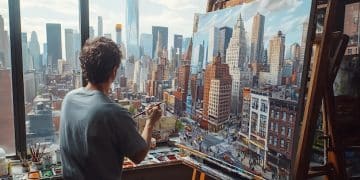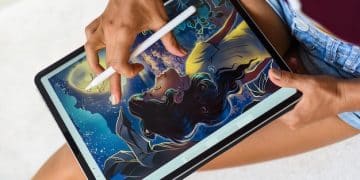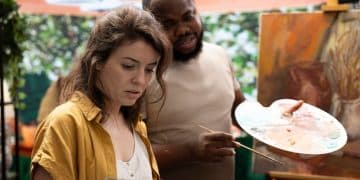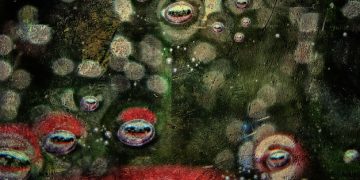Master Digital Art in 3 Months: Procreate Guide for US Beginners
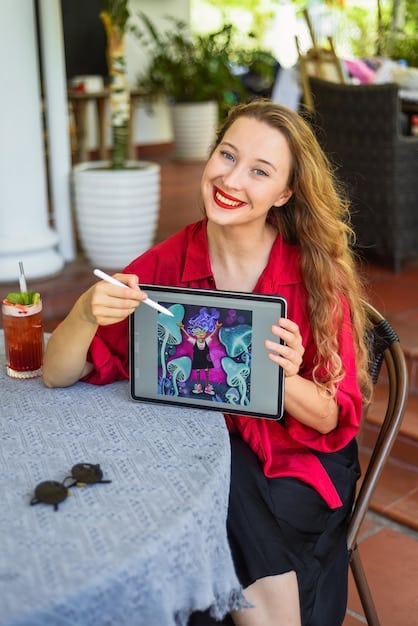
Mastering digital art with Procreate in just three months is an ambitious but achievable goal for beginners in the US, requiring dedicated practice, structured learning, and consistent application of fundamental drawing principles to unlock creative potential rapidly.
Embarking on the journey of digital art can feel daunting, especially for beginners aiming for rapid progress. However, with the right tools and a focused approach, achieving proficiency in a short timeframe is entirely possible. This guide, “3 Months to Master Digital Art: A Beginner’s Guide to Procreate in the US“, is meticulously crafted to empower aspiring artists from the United States, providing a structured roadmap to unlock their creative potential using the powerful Procreate app on the iPad.
The Procreate Advantage: Why it’s the Go-To for US Beginners
Procreate has swiftly become the preferred digital art application for many artists, particularly beginners. Its intuitive interface, robust feature set, and affordability make it an unmatched tool for learning and creation. For US-based artists, the accessibility of resources and a thriving online community further bolster its appeal, making it an ideal starting point for a rapid learning curve.
Understanding Procreate’s core functionalities is the first step towards mastery. Familiarize yourself with the primary tools: brushes, layers, selection, and adjustments. Each plays a crucial role in the digital art workflow, and a solid grasp of these basics will accelerate your learning significantly.
Understanding the Interface and Essential Tools
Upon opening Procreate, you’ll be greeted by a minimalist yet powerful interface. The toolbar at the top houses your essential drawing tools, while the brush and layer panels offer extensive customization. Spending time exploring each icon and its function will demystify the app and build your confidence.
- Brushes: Procreate offers an extensive library of brushes, from pencils to watercolors. Experiment with different textures and effects to understand their application.
- Layers: Layers are fundamental. They allow you to separate elements of your artwork, making editing and refining a non-destructive process.
- Gestures: Procreate relies heavily on intuitive touch gestures for quick actions like undo, redo, and accessing menus. Learning these shortcuts will dramatically improve your workflow speed.
The Procreate community in the US is vast and supportive. Online forums, YouTube tutorials, and dedicated art communities offer a wealth of information and inspiration. Engaging with this community can provide answers to technical questions and foster a sense of belonging, driving your motivation forward.
Beyond the technical aspects, Procreate fosters creative experimentation. Its undo/redo functionality and non-destructive editing encourage artists to take risks and try new techniques without fear of permanent mistakes. This freedom is paramount for a beginner’s growth.
Month 1: Building Solid Foundations – The ABCs of Digital Drawing
The first month of your digital art journey with Procreate should focus exclusively on fundamental drawing principles. Think of this as laying the groundwork upon which all your future artistic endeavors will be built. Skipping these crucial steps will likely lead to frustration down the line, so commit to mastering them.
Understanding form, perspective, and composition is not unique to digital art; these are universal concepts. Procreate simply provides a new medium to practice and apply them. Dedicate specific time each day to exercises that reinforce these basics, ensuring a strong base for more complex projects.
Mastering Basic Shapes and Line Control
Start with simple exercises: drawing straight lines, perfect circles, and various geometric shapes freehand. Procreate offers drawing guides and QuickShape features that can aid in this, but striving for accuracy without assistance is crucial for developing motor skills.
- Line Economy: Practice drawing objects with the fewest possible lines, focusing on capturing their essence rather than every detail.
- Shading Fundamentals: Experiment with hatching, cross-hatching, and stippling to create different tonal values and imply form.
- Form Studies: Draw basic 3D shapes like cubes, spheres, and cylinders from various angles, paying attention to light and shadow.
Perspective is often a daunting subject, but essential for creating convincing depth. Begin with one-point perspective, drawing simple rooms or roads, then move to two-point perspective for more complex structures. Procreate’s drawing guides can be an invaluable asset here, but don’t rely on them exclusively; try to understand the underlying principles.
Composition refers to how elements are arranged within your artwork. Practice the rule of thirds, leading lines, and balancing positive and negative space. Analyzing existing art for its compositional strengths can provide valuable insights and inspire your own arrangements.
Month 2: Unleashing Color and Light – Bringing Your Art to Life
Having established a strong foundation in form and composition, your second month should transition into the vibrant world of color and light. This is where digital art truly blossoms, as Procreate offers an unparalleled range of tools to manipulate hues, values, and luminosity. Understanding color theory is paramount at this stage.
Color is more than just aesthetics; it conveys emotion, directs the viewer’s eye, and establishes mood. Begin by studying the color wheel and understanding concepts like complementary, analogous, and monochromatic color schemes. Procreate’s color palettes and adjustment layers will be your best friends.
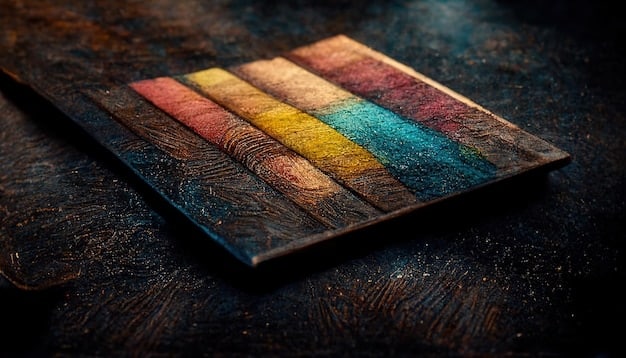
Exploring Color Theory and Application in Procreate
Don’t be afraid to experiment. Digital art provides the freedom to undo and retry, allowing for fearless exploration of color combinations. Start with simple still-life studies, focusing purely on accurate color representation and how light interacts with different surfaces.
- Hue, Saturation, Value: Learn how these three components define every color. Procreate’s HSB slider is excellent for understanding these relationships.
- Color Palettes: Create and save your own palettes. Research existing palettes from famous artists or movies to see how professionals use color.
- Blending Modes: Procreate’s layer blending modes offer powerful ways to combine colors and textures, creating unique effects.
Light is what gives form and dimension to your colors. Practice rendering different lighting scenarios: direct sunlight, soft ambient light, and dramatic backlighting. Pay attention to how shadows are cast and how highlights catch the light on various surfaces.
Once comfortable with basic color and light, begin applying it to your own concepts. Try reimagining your line drawings from Month 1 with full color, experimenting with different moods and atmospheres. This is where your personal style will start to emerge, driven by your unique color choices.
Month 3: Advanced Techniques and Personal Style – Defining Your Artistic Voice
Your final month is dedicated to refining your skills, exploring advanced features, and, most importantly, discovering and developing your unique artistic voice. By now, you should feel comfortable with Procreate’s interface and the fundamental principles of art. This month is about pushing boundaries and specializing.
Advanced Procreate features offer powerful ways to enhance your workflow and achieve complex effects. From custom brushes to animation, these tools can elevate your art significantly. Don’t feel pressured to master them all, but identify which ones align with your artistic interests.
Diving into Custom Brushes and Textures
Procreate’s brush engine is incredibly versatile. Learning to modify existing brushes or even create your own can drastically expand your expressive capabilities. Textures, whether applied through brushes or layer effects, add depth and realism to your digital paintings.
- Brush Customization: Explore the Brush Studio to tweak settings like shape, grain, dynamics, and rendering.
- Alpha Lock & Clipping Masks: These features are invaluable for painting within specific areas or adding details without affecting underlying layers.
- Liquify & Warp: Experiment with these tools for non-destructive adjustments to shape and form, perfect for caricatures or abstract work.
Developing a personal style isn’t about finding a singular trick; it’s a culmination of your chosen techniques, color palettes, subject matter, and storytelling. Reflect on what art truly resonates with you and what messages you want to convey. Consistent practice and self-critique are key during this phase.
Consider tackling more ambitious projects: character design, environmental painting, or even short animated loops using Procreate’s animation assist. These larger projects will challenge your combined skills and help solidify your artistic identity. Seek constructive feedback from others to gain fresh perspectives on your work.

Essential Tools and Resources for US Procreate Artists
While Procreate itself is a powerful standalone tool, a few additional resources and accessories can significantly enhance your learning and creative experience, especially for artists in the US. Investing wisely in these can yield greater comfort and efficiency, complementing your three-month journey to mastery.
The iPad and Apple Pencil are the core components of the Procreate ecosystem. While various iPad models support Procreate, a newer model with Apple Pencil 2 offers pressure sensitivity and gesture controls that are crucial for a natural drawing experience. Ensure your device meets the recommended specifications for optimal performance.
Must-Have Hardware and Software Add-ons
Beyond the iPad, a good quality screen protector can mimick the feel of paper, offering a more tactile drawing experience. Many artists also find a comfortable stand or ergonomic setup beneficial for long drawing sessions, preventing strain and promoting focus.
- Apple Pencil: Essential for pressure sensitivity and precise line work.
- Paperlike Screen Protector: Adds a tactile, paper-like feel to your iPad screen, improving drawing comfort.
- External Storage/Cloud Services: Crucial for backing up your artwork and freeing up iPad space.
The internet is a treasure trove of learning resources. YouTube features countless free Procreate tutorials, ranging from beginner introductions to advanced techniques. Websites like Gumroad and Skillshare offer premium courses from professional artists, providing structured learning paths and in-depth knowledge.
Connecting with the digital art community is invaluable. Online forums, social media groups, and local US art meetups offer opportunities to share work, receive feedback, and find inspiration. Learning from peers and mentors can accelerate your growth and provide motivation when challenges arise.
Overcoming Common Beginner Hurdles in Digital Art
Every artist, regardless of medium, faces challenges. As a beginner in digital art with Procreate, you will encounter specific hurdles that can sometimes feel discouraging. Recognizing these common issues and having strategies to overcome them is crucial for maintaining momentum and achieving your three-month goal.
One of the most frequent frustrations is the “blank canvas syndrome,” the feeling of being overwhelmed by an empty digital space. This often stems from a lack of clear direction or fear of making mistakes. Remember, the digital medium allows for infinite undo; embrace experimentation.
Strategies for Battling Creative Blocks and Technical Glitches
Technical issues, though less common with a stable app like Procreate, can still pop up. Slowdowns, app crashes, or unexpected brush behavior can disrupt your flow. Familiarize yourself with Procreate’s settings and basic troubleshooting steps, such as clearing cache or reinstalling the app.
- Reference Usage: Don’t be afraid to use reference photos for anatomy, perspective, or color inspiration. It’s a learning tool, not cheating.
- Breaks & Exercise: Step away when frustrated. Short breaks can reset your mind and help you see your work with fresh eyes. Physical movement is also vital for health.
- Seeking Feedback: Share your work with trusted friends, mentors, or online communities. Constructive criticism is invaluable for growth.
Comparing your work to professional artists is another pitfall. While inspiring, constant comparison can lead to self-doubt. Focus on your own progress and celebrate small victories. Every artist journey is unique, and consistent effort is more important than immediate perfection.
Finally, consistency is key. Even 15-30 minutes of practice daily is more effective than one long session once a week. Build a routine, protect your creative time, and remember why you started this journey. The dedication you put in will undoubtedly reflect in your progress.
Setting Realistic Goals and Measuring Progress
Mastering digital art in three months is an ambitious goal, but “mastery” for a beginner entails reaching a strong foundational competency, not rivaling seasoned professionals. Setting realistic, measurable goals is vital to avoid burnout and maintain motivation throughout your intensive learning period.
Break down the overarching goal into smaller, weekly or bi-weekly objectives. For example, instead of “master perspective,” aim for “draw 10 objects in one-point perspective” this week. This makes the journey feel more manageable and provides tangible achievements.
Structuring Your Learning Path for Maximum Impact
Keep a digital sketchbook or a dedicated folder in Procreate for your daily practices and studies. This visual log will serve as a powerful reminder of how far you’ve come. Looking back at early attempts versus current work can be incredibly motivating and highlight areas of improvement.
- Daily Practice Log: Document what you practiced, for how long, and what you learned. This helps in identifying patterns and areas needing more attention.
- Weekly Review: At the end of each week, compare your current work to your goals. What went well? What needs improvement?
- Challenge Projects: Periodically take on a more complex project that tests multiple skills learned over the weeks. This synthesizes your knowledge.
Don’t be afraid to adjust your goals. Life happens, and some topics might require more time than initially anticipated. Flexibility is a strength, not a weakness. The aim is continuous learning and improvement, not rigid adherence to a schedule that no longer serves you.
Celebrate your milestones, no matter how small. Finishing a complex drawing, finally understanding a challenging concept, or receiving positive feedback are all reasons to acknowledge your hard work. Positive reinforcement fuels motivation and reinforces the joy of creation.
| Key Area | Brief Description |
|---|---|
| 🎨 Procreate Interface | Familiarize yourself with brushes, layers, and gestures for efficient digital art creation. |
| ✍️ Foundational Skills | Master basic shapes, line control, perspective, and composition for strong artwork. |
| 🌈 Color & Light | Explore color theory, blending modes, and various lighting scenarios to add depth. |
| 🚀 Advanced Techniques | Customize brushes, use masks, and develop personal style for unique artistic expressions. |
Frequently Asked Questions About Procreate Mastery
While “mastery” is subjective, significant proficiency and a strong foundation are absolutely achievable in three months with dedicated, consistent practice. This guide focuses on building essential skills and understanding core functionalities rather than becoming a seasoned professional immediately. Your progress will be a direct reflection of your commitment and daily effort.
For the best experience, an iPad Pro or a newer iPad Air model is highly recommended, paired with an Apple Pencil 2. These offer superior performance, pressure sensitivity, and low latency, which are crucial for a natural drawing feel. Older models might work, but could limit certain features or responsiveness for demanding artistic tasks.
Consistency is more important than duration. Aim for at least 1-2 hours of focused practice daily. If that’s not feasible, even 30 minutes every day can yield significant results over three months. Break down your practice into smaller, manageable chunks to avoid burnout and keep the learning process enjoyable and effective.
Absolutely! YouTube is a goldmine for free Procreate tutorials, offering everything from basic introductions to advanced techniques. Many artists also share free brush sets and tips on platforms like Instagram and Pinterest. Engaging with online art communities can also provide valuable insights and support at no cost.
Developing a personal style starts with extensive experimentation and self-reflection. Don’t be afraid to try different techniques, color palettes, and subject matter. Analyze art you admire, but always aim to adapt and integrate elements in your unique way. Consistent practice, critical self-assessment, and seeking feedback are key to refining your artistic voice.
Conclusion
The journey to mastering digital art with Procreate in three months is an intensive yet incredibly rewarding endeavor. By meticulously following a structured plan, focusing on foundational principles, and consistently pushing your creative boundaries, you can transform from a complete beginner into a confident digital artist. Remember that the path to mastery is continuous, but these foundational months will equip you with the essential tools, knowledge, and confidence to continue exploring the vast possibilities of digital art long after your initial three-month sprint.
